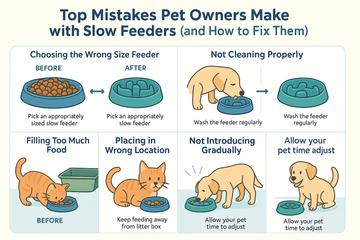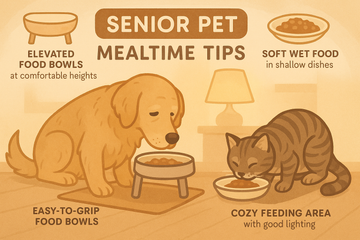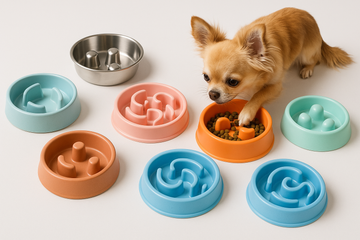Slow feeders can transform chaotic meals into calm, digestible routines—but only if they’re used correctly. From choosing the wrong pattern to introducing the bowl too fast, small missteps can lead to frustration, mess, or back-to-square-one gulping. Below are the top slow feeder mistakes we see most often plus pro fixes you can implement today.
1) Picking the Wrong Pattern for Your Pet’s Face
The mistake: Deep, narrow mazes for flat-faced dogs/cats; ultra-shallow patterns for long-muzzled pets.
Why it backfires: Pets either give up (too hard) or still inhale food (too easy).
Fix:
-
Brachycephalic (Frenchie, Shih Tzu, Persian): Shallow, wide lanes or lick mats.
-
Medium/long muzzle (Border Collie, Beagle): Moderate depth spirals/mazes.
-
Cats: Whisker-friendly, wide & shallow designs.
Start easy; increase difficulty by small steps (10–20%).
2) Using a Bowl That’s Too Big
The mistake: Oversized bowls encourage overserving and scooping behavior.
Fix: Match capacity to the actual meal volume (e.g., 0.5–1.5 cups for small breeds/cats, 1.5–3 cups for medium/large dogs). Smaller footprint = slower pace + better portion control.
3) Slippery, Noisy Feeding Stations
The mistake: Lightweight plastic on tile/wood; clatter triggers anxiety and pawing.
Fix: Choose heavy ceramic or stainless with silicone base; place on a non-slip mat. A stable, quiet setup reduces arousal and improves focus.
4) Skipping the Gradual Introduction
The mistake: Full meal on “hard mode” on day one.
Fix:
-
Day 1–2: 50% portion, easy configuration (wider channels or partial lick layer).
-
Day 3–4: 75–100% portion, add mild texture (thin smear of pumpkin/pâté under kibble).
-
Day 5+: Increase maze complexity or lightly chill the lick layer to extend time.
5) Forgetting Texture Strategy
The mistake: Only dry kibble in a steep maze = frustration.
Fix: Layer: thin wet base (pumpkin, pâté, kefir) → sprinkle kibble → optional drizzle of low-sodium broth. For wet-only diets, use lick mats or shallow puzzles.
6) Elevation Errors (Too High or Too Low)
The mistake: Extreme elevation or nose-to-floor posture.
Fix: Aim for a gentle lift (1–3 in / 3–8 cm rim height). You want a neutral neck & flat back, not stretching or crouching. Especially helpful for seniors.
7) Treats Not Counted (Calorie Creep)
The mistake: Adding toppers/treats to “motivate,” but not subtracting from daily calories.
Fix: Treats ≤ 10% of daily calories. If toppers go up, reduce main ration accordingly. Use a kitchen scale for accuracy.
8) Ignoring Hygiene & Wear
The mistake: Scratched plastic or chipped bowls harbor bacteria and odors.
Fix: Prefer glazed ceramic or stainless; wash after every meal (especially lick mats). Replace any chipped or deeply scratched surfaces.
9) Expecting the Feeder to Solve Medical Issues
The mistake: Using a slow feeder as the only fix for chronic vomiting, diarrhea, weight loss, or pain.
Fix: Slow feeding helps behavioral pace and mild GI discomfort, but persistent symptoms require a vet check (dietary intolerance, dental pain, GI disease).
10) Hovering, Rushing, or Free-For-All
The mistake: Standing over the bowl (pressure) or leaving food out all day (grazing → binge later).
Fix: Feed in a quiet, consistent spot. Set 10–20 minutes per session; pick up leftovers. Multi-pet homes: feed separately to remove competition.
Quick Setup Checklist
-
□ Pattern fits muzzle/whiskers (not too deep, not too shallow)
-
□ Capacity matches the actual portion
-
□ Heavy/stable bowl + non-slip mat (quiet!)
-
□ Gentle elevation (1–3 in) if needed
-
□ Texture layered for success (wet base + kibble)
-
□ Wash & sanitize daily; retire damaged bowls
-
□ Track meal duration (goal: 10–20 minutes)
7-Day “Fix the Feeder” Plan
Day 1–2: 50% portion, easy maze. Add a teaspoon of wet base.
Day 3–4: 75–100% portion, widen distribution; try slight elevation.
Day 5: Add texture layering or a short chill (5–10 min) for lick mats.
Day 6: If <5 min finish, tighten maze one notch. If frustration, loosen.
Day 7: Lock routine: same place/time, calm release, remove leftovers at 15–20 min.
Pet Training Tips That Supercharge Mealtime
-
Pre-meal decompression (60–120s): Nosework or simple cues (sit/place) reduce arousal.
-
Mark calm behavior: Quiet praise when your pet engages the feeder softly.
-
Rotate difficulty: Keep engagement without creating stress—alternate maze & lick formats.
-
End on a win: A few easy finds at the end sustain motivation for tomorrow.
GEO Tips (USA • UK • Canada • Australia)
-
slow feeder USA: Dishwasher-safe ceramic or stainless with silicone rings; ideal for open kitchens and hardwood floors.
-
feeding guide UK: Compact, metric-marked portion bowls; shallow spirals for small flats and short-snout breeds.
-
dog mealtime Canada: Heavier ceramics prevent sliding on winter-slick floors; freezer-friendly lick mats for summer.
-
pet feeding Australia: Heat-resistant glazed ceramics; slight elevation for tiled, open-plan homes; hydration emphasis in warmer months.
FAQ (SEO Boosters)
Q: How long should a slow-feeder meal take?
A: 10–20 minutes is a solid target. Under 3 minutes = too easy; visible frustration = too hard.
Q: Is a slow feeder good for cats too?
A: Yes—use whisker-friendly shallow patterns or lick mats for wet food.
Q: Can slow feeders cause tooth wear?
A: With rounded ridges (ceramic/stainless) and proper fit, no. Avoid sharp edges and replace damaged gear.
Q: Do I need elevation?
A: Not always. Try a gentle lift if your pet pushes the bowl, hunches, or is a senior.
Turn Mistakes into Mealtime Wins
Set the right pattern, size, texture, and routine—and your slow feeder will finally do its job: calmer behavior, safer pace, and happier tummies.
👉 Upgrade your setup with heavy, whisker-friendly ceramics, lick mats, and elevated stands at Noka&Aurorastone.




